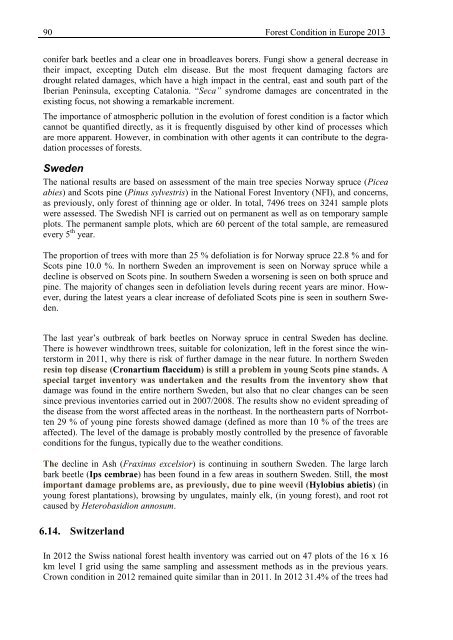Forest Condition in Europe - ICP Forests
Forest Condition in Europe - ICP Forests
Forest Condition in Europe - ICP Forests
Create successful ePaper yourself
Turn your PDF publications into a flip-book with our unique Google optimized e-Paper software.
90 <strong>Forest</strong> <strong>Condition</strong> <strong>in</strong> <strong>Europe</strong> 2013<br />
conifer bark beetles and a clear one <strong>in</strong> broadleaves borers. Fungi show a general decrease <strong>in</strong><br />
their impact, except<strong>in</strong>g Dutch elm disease. But the most frequent damag<strong>in</strong>g factors are<br />
drought related damages, which have a high impact <strong>in</strong> the central, east and south part of the<br />
Iberian Pen<strong>in</strong>sula, except<strong>in</strong>g Catalonia. “Seca” syndrome damages are concentrated <strong>in</strong> the<br />
exist<strong>in</strong>g focus, not show<strong>in</strong>g a remarkable <strong>in</strong>crement.<br />
The importance of atmospheric pollution <strong>in</strong> the evolution of forest condition is a factor which<br />
cannot be quantified directly, as it is frequently disguised by other k<strong>in</strong>d of processes which<br />
are more apparent. However, <strong>in</strong> comb<strong>in</strong>ation with other agents it can contribute to the degradation<br />
processes of forests.<br />
Sweden<br />
The national results are based on assessment of the ma<strong>in</strong> tree species Norway spruce (Picea<br />
abies) and Scots p<strong>in</strong>e (P<strong>in</strong>us sylvestris) <strong>in</strong> the National <strong>Forest</strong> Inventory (NFI), and concerns,<br />
as previously, only forest of th<strong>in</strong>n<strong>in</strong>g age or older. In total, 7496 trees on 3241 sample plots<br />
were assessed. The Swedish NFI is carried out on permanent as well as on temporary sample<br />
plots. The permanent sample plots, which are 60 percent of the total sample, are remeasured<br />
every 5 th year.<br />
The proportion of trees with more than 25 % defoliation is for Norway spruce 22.8 % and for<br />
Scots p<strong>in</strong>e 10.0 %. In northern Sweden an improvement is seen on Norway spruce while a<br />
decl<strong>in</strong>e is observed on Scots p<strong>in</strong>e. In southern Sweden a worsen<strong>in</strong>g is seen on both spruce and<br />
p<strong>in</strong>e. The majority of changes seen <strong>in</strong> defoliation levels dur<strong>in</strong>g recent years are m<strong>in</strong>or. However,<br />
dur<strong>in</strong>g the latest years a clear <strong>in</strong>crease of defoliated Scots p<strong>in</strong>e is seen <strong>in</strong> southern Sweden.<br />
The last year’s outbreak of bark beetles on Norway spruce <strong>in</strong> central Sweden has decl<strong>in</strong>e.<br />
There is however w<strong>in</strong>dthrown trees, suitable for colonization, left <strong>in</strong> the forest s<strong>in</strong>ce the w<strong>in</strong>terstorm<br />
<strong>in</strong> 2011, why there is risk of further damage <strong>in</strong> the near future. In northern Sweden<br />
res<strong>in</strong> top disease (Cronartium flaccidum) is still a problem <strong>in</strong> young Scots p<strong>in</strong>e stands. A<br />
special target <strong>in</strong>ventory was undertaken and the results from the <strong>in</strong>ventory show that<br />
damage was found <strong>in</strong> the entire northern Sweden, but also that no clear changes can be seen<br />
s<strong>in</strong>ce previous <strong>in</strong>ventories carried out <strong>in</strong> 2007/2008. The results show no evident spread<strong>in</strong>g of<br />
the disease from the worst affected areas <strong>in</strong> the northeast. In the northeastern parts of Norrbotten<br />
29 % of young p<strong>in</strong>e forests showed damage (def<strong>in</strong>ed as more than 10 % of the trees are<br />
affected). The level of the damage is probably mostly controlled by the presence of favorable<br />
conditions for the fungus, typically due to the weather conditions.<br />
The decl<strong>in</strong>e <strong>in</strong> Ash (Frax<strong>in</strong>us excelsior) is cont<strong>in</strong>u<strong>in</strong>g <strong>in</strong> southern Sweden. The large larch<br />
bark beetle (Ips cembrae) has been found <strong>in</strong> a few areas <strong>in</strong> southern Sweden. Still, the most<br />
important damage problems are, as previously, due to p<strong>in</strong>e weevil (Hylobius abietis) (<strong>in</strong><br />
young forest plantations), brows<strong>in</strong>g by ungulates, ma<strong>in</strong>ly elk, (<strong>in</strong> young forest), and root rot<br />
caused by Heterobasidion annosum.<br />
6.14. Switzerland<br />
In 2012 the Swiss national forest health <strong>in</strong>ventory was carried out on 47 plots of the 16 x 16<br />
km level I grid us<strong>in</strong>g the same sampl<strong>in</strong>g and assessment methods as <strong>in</strong> the previous years.<br />
Crown condition <strong>in</strong> 2012 rema<strong>in</strong>ed quite similar than <strong>in</strong> 2011. In 2012 31.4% of the trees had
















